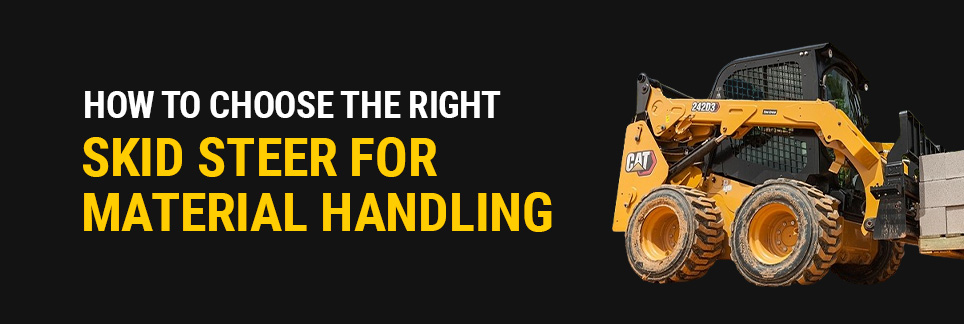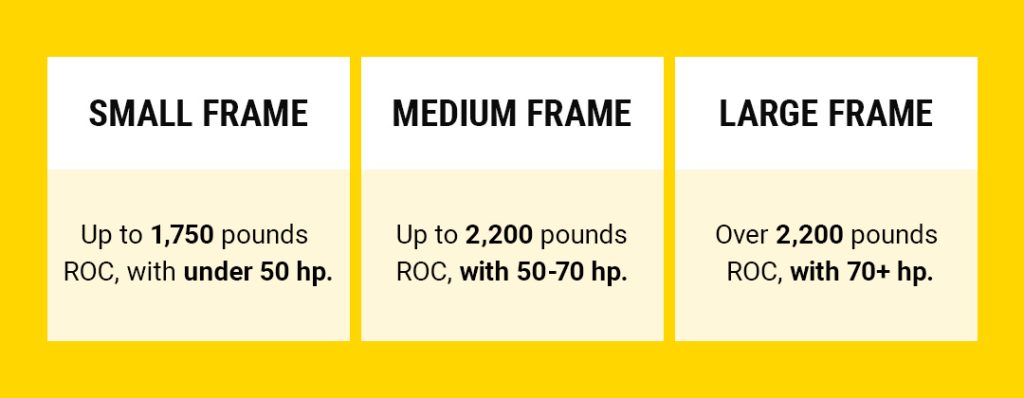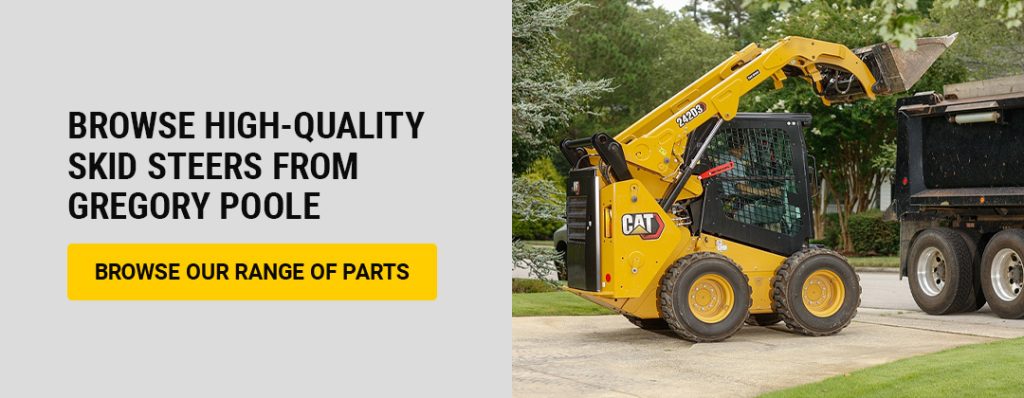
Whether you work on commercial landscaping or manage extensive construction projects, having the right machinery for every task is essential for productivity and accuracy. A skid steer can provide nearly endless benefits for your team, especially when it comes to material handling jobs.
These compact pieces of equipment — also called skid steer loaders or wheel loaders — feature either four wheels or two tracks and come with the ability to equip numerous attachments. As a result, skid steers are extremely versatile, so you can use one for multiple different tasks.
When choosing a skid steer for material handling, you want to assess your specific needs and requirements to select the best option. Gregory Poole Equipment Company is here to help you make the right choice — explore the top considerations before investing in a skid steer below.
Understanding how to choose a skid steer begins with assessing your operation’s unique needs. Specifically, the types of materials you typically transport will impact the size, power and attachments you require.
For instance, if you frequently haul mulch, sod and soil for landscaping jobs, you’ll likely want a small to medium-sized skid steer with bucket and pallet attachments to help you move loose and bagged material. In comparison, hauling considerably heavier materials like steel beams and lumber requires a skid steer with a larger frame and higher operating capacity.
These materials all have different weights and configurations. Keep your material handling specifications in mind as you browse your options and compare skid steer sizes, weights and operating capacities.
Similarly, you’ll want to think about whether you typically lift or move material — or both. There are vertical and radial lift skid steers, and which one you choose comes down to whether you need to lift material to certain heights. A vertical lift reaches more extensive heights, which is ideal for lifting. A radial lift is more suitable for moving material and doesn’t reach as high.
One final point to think about is where you typically handle materials. The type of surface you work on — such as rough terrain vs. pavement — will determine whether your skid steer should have wheels or tracks.
Various aspects of skid steers influence their power and performance. The first indicator you may think of is horsepower (hp). While it’s still important to consider engine horsepower, it’s equally as essential to consider all other indicators of performance, as horsepower alone isn’t all-encompassing.
Specifically, breakout force — the maximum amount of upward force a skid steer can use to lift an object — is a key indicator of skid steer power. If you attempt to exceed a skid steer’s breakout force, you risk compromising project efficiency and damaging the machine, making it crucial to consider when selecting a skid steer. Some factors that influence breakout force include hydraulic cylinder size, angle and pressure.
Alongside breakout force, machine weight, axle torque and the hydraulic system can also significantly impact a skid steer’s performance.

Generally, larger skid steers can handle more substantial loads. The amount of weight a skid steer can successfully handle without tipping over or malfunctioning is referred to as its rated operating capacity (ROC). This figure is typically calculated as 50% of the machine’s tipping load. Every skid steer comes with an ROC, which you should consider in relation to the weights of the materials your team usually handles.
It’s important to note that ROC isn’t the same as operating weight. The operating weight refers to how much a skid steer weighs with a full tank of gas and an average-sized operator (approximately 165 pounds) — not how much material weight it can handle. For example, a skid steer may have a 50% tipping load of 2,185 pounds but have a maximum operating weight of 7,434 pounds.
As you browse skid steers, you’ll see them categorized into three main frame sizes, which are based on their ROC and horsepower:
While different frame sizes give you insights into crucial distinctions between ROC, operating weight and horsepower, each frame size also differs in maneuverability. A skid steer’s size influences how easy it is for an operator to drive it around the jobsite. For instance, if you’re working in a tight, compact space, such as an urban construction site, you may need to choose a small skid steer despite its ROC and horsepower.
Overall, you’ll want to consider the ROC and horsepower you need from a skid steer, as well as its physical dimensions and how they might impact equipment mobility.
Nearly all skid steers offer universal attachment capabilities. This means you should be able to attach almost any kind of attachment to your skid steer, regardless of its brand or model.
That said, some attachments require specific amounts of hydraulic power to operate. You’ll need to pay close attention to the material handling attachments you need and their compatibility with the skid steers you’re interested in. Some of the best attachments used for skid steers for material handling include:
If you’re unsure whether a specific attachment will be compatible with the skid steer you want, reach out to a reputable equipment dealer to learn more and help you make an informed choice.
Every jobsite manager wants to invest in highly durable and powerful pieces of equipment for their fleets. However, your operators’ experience with the machinery matters, too. The skid steer you decide on should be comfortable and accessible for all operators on your team.
Keep an eye out for the following skid steer cabin features:
Investing in a skid steer with the latest technology and a comfortable and secure cabin environment can help your operators perform at their best. As a result, they’ll be more productive across the jobsite and complete tasks more efficiently and accurately. Plus, having enhanced safety features helps keep your team protected.
With a variety of skid steer loaders at your fingertips, including highly durable models from Cat®, you can find exactly what you want at Gregory Poole — along with the support you need to make a great decision.
The experienced team at Gregory Poole Equipment Company understands that choosing heavy equipment for your fleet takes significant time and consideration. That’s why we’re here to offer you expert advice and support throughout the buying process. With more than 70 years in the business, we have a wealth of knowledge to help you choose the right skid steer for your operations.
Whether you’re interested in a new machine or want to explore used and rental options, we’ll work with you to assess your material handling requirements and other considerations. Get started with selecting a skid steer today by finding a representative near you, or contact us via our form!
